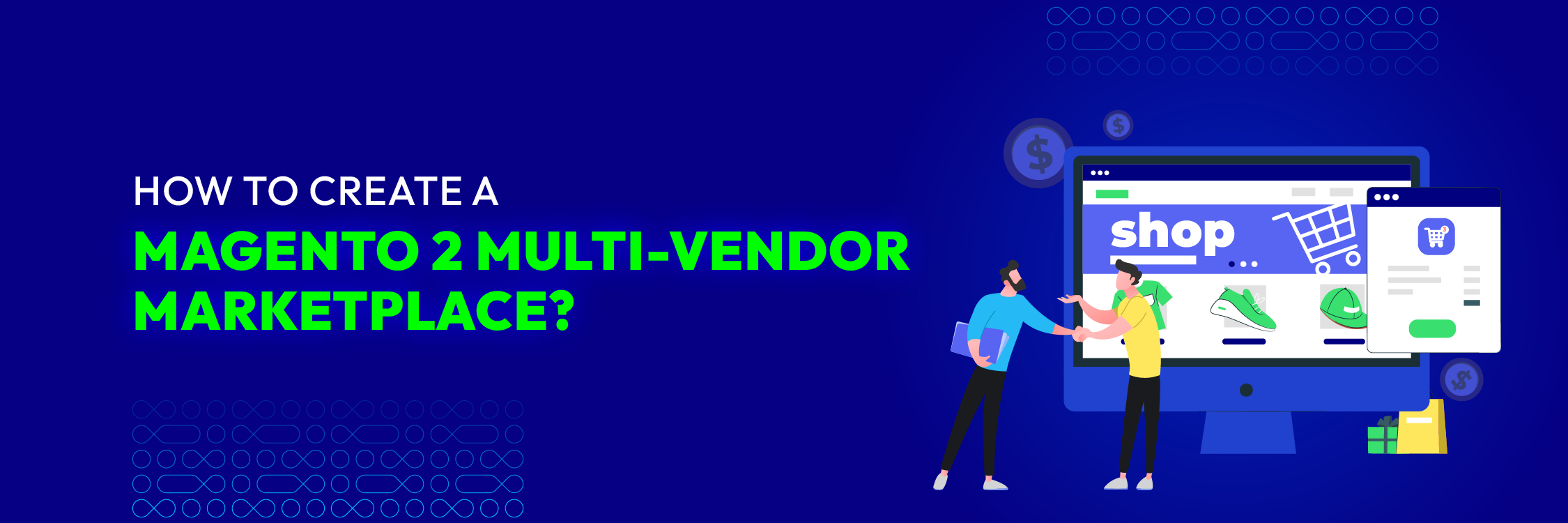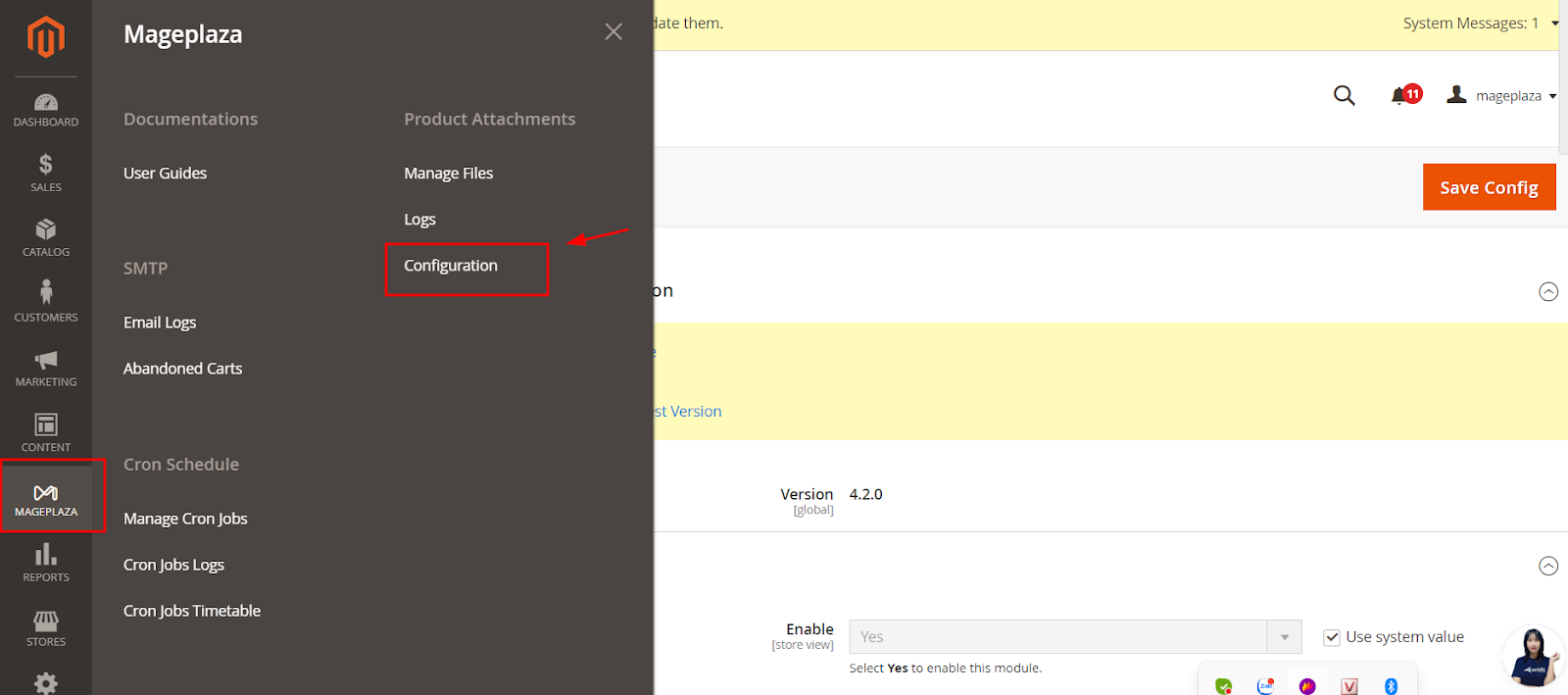How to Create a Magento 2 Multi-Vendor Marketplace?

Starting a Magento 2 multi-vendor marketplace is a great way to enter the booming eCommerce industry, which is expected to see sales skyrocket to $9.6 trillion globally by 2027. These online marketplaces, where multiple sellers offer a variety of products, are a key driver in this growth.
Magento 2 is known for its powerful tools and adaptability, making it a top choice for business owners looking to create their own marketplace. In this guide, we’ll explore how to set up a Magento 2 multi-vendor marketplace. We’ll cover the basic steps, strategies, and important considerations to help you launch a successful online marketplace.
What is a Multi-Vendor eCommerce Marketplace?
A Multi-Vendor eCommerce Marketplace is an online platform where multiple sellers can list and sell their products. Each vendor operates independently within the same storefront, managed by a central administrator. This type of marketplace is similar to well-known platforms like Amazon or eBay, where a wide range of products are available from different sellers.

Read more: How to Launch a B2B Multi-Vendor Marketplace Successfully
Key Components of a Multi-Vendor eCommerce Marketplace
Product Management
-
Vendors can independently upload and manage their product listings.
-
Includes features such as adding product details, images, and pricing.
- The marketplace administrator approves products to maintain quality control.
Order Management
-
Vendors can view and manage customer orders related to their products.
-
Includes order processing, shipment tracking, and updating order statuses.
- The central system ensures all transactions are recorded and processed efficiently.
Vendor Management
-
Administrators can oversee all vendor activities on the platform.
-
Features include registration approval, monitoring sales, and setting commission rates.
-
Helps ensure vendors adhere to marketplace policies and standards.
Customer Management
-
Tools for managing customer accounts, preferences, and loyalty points.
-
Enables communication between customers and vendors for inquiries and support.
-
Important for maintaining customer satisfaction and handling disputes.
Payment Management
-
Supports multiple payment methods and gateways for transactions.
-
Includes split payment features to distribute earnings between vendors and the marketplace owner.
-
Secure payment processing is crucial to protect both sellers and buyers.
Advantage of Using Magento 2 For Multi Vendor Marketplace Development?
Magento 2 is widely recognized as an ideal platform for developing a multi-vendor eCommerce marketplace due to its powerful features and extensive customization capabilities. Here are some compelling reasons to choose Magento 2 for building a multi-vendor marketplace:
Scalability
-
Adapts to Growth: Magento 2 is built to support businesses of varying sizes and can easily accommodate growth, making it perfect for marketplaces that plan to scale up.
-
Handles Increasing Load: It manages increased product listings and user traffic without compromising performance.
Customization
-
Flexible Design Options: Magento 2 offers numerous plugins and themes that enhance the functionality and appearance of your online store.
-
Tailored Solutions: Business owners can work with developers to create a unique and highly customized shopping experience.
Third-Party Integration
-
Enhanced Functionality: Supports integrations with a variety of third-party services including payment processors like PayPal and Sage Pay, and marketing tools like Nosto and MailChimp.
-
Seamless Integration: Easy connectivity with various web applications broadens the functional scope of the marketplace.

Extensive Range of Add-ons
-
Rich Library of Extensions: Magento 2 offers an extensive assortment of both free and paid extensions that augment your marketplace’s capabilities.
-
Custom Modules: Essential modules such as those for order management, payment management, and vendor management can be seamlessly integrated.
Access to 50+ Payment Gateways
-
Flexible Payment Options: With over 50 payment gateways, Magento 2 allows customers to pay using their preferred methods, enhancing user satisfaction.
-
Secure Transactions: Ensures secure handling of payments, instilling trust among buyers.
SEO Optimization
Better Search Engine Ranking: Magento 2 is optimized for search engines, helping your marketplace achieve higher rankings in search results.
Steps to Establish a Multi-Vendor Marketplace Using Magento 2
Creating a dynamic multi-vendor marketplace with Magento 2 involves several structured steps. Each step focuses on building strong foundational elements essential for a robust, efficient, and user-friendly platform. Here’s how you can approach each stage:
Step 1: Setting Up The Basic Store
Install Magento 2: Begin by installing Magento 2 software on a suitable hosting environment that meets its system requirements.
Configuration: Configure the basic settings including store information, currencies, languages, and tax settings to align with your business location and operational needs.

Step 2: Choosing an Appropriate Theme
Theme Selection: Select a theme that not only reflects your brand’s visual identity but is also responsive and compatible with multi-vendor features.
Customization: Customize the theme to ensure it provides a great user experience and works well on mobile devices. Consider hiring a designer if necessary to tweak the aesthetics and functionality.
Step 3: Installing Essential Extensions
Multi-Vendor Extension: Choose a robust multi-vendor marketplace extension for Magento 2 which offers comprehensive functionalities for managing vendors.
Additional Extensions: Depending on your needs, you might also want to install other extensions for SEO, payment processing, advanced shipping methods, and more to enhance the store’s capabilities.
Step 4: Creating The Marketplace
-
Vendor Registration: Set up a vendor registration form and approval system. This controls who can sell on your marketplace and ensures that you maintain high-quality standards.
-
Vendor Dashboards: Ensure each vendor has access to a dashboard where they can manage their products, track sales, and view earnings.
-
**Product Management: Implement a system where vendors can submit their products for approval before they go live. This helps maintain consistency and quality across your marketplace.
-
Commission Setup: Decide on the commission you will take from vendors and set up the payment processes accordingly. Ensure transparency in how fees are calculated and communicated.
-
Customer Service: Establish a support system for both vendors and customers to handle inquiries and resolve issues swiftly.
Choosing a Magento Development Company to Build Your Marketplace
When selecting a Magento development company to build your multi-vendor marketplace, there are several key factors to consider:
Magento Expertise:
-
Search for a company with a lot of experience and a history of success in developing with Magento 2.
-
Ensure they have a team of certified Magento developers who are well-versed in the platform’s features and best practices.
Multi-Vendor Marketplace Experience:
-
Prioritize agencies that have successfully delivered multi-vendor marketplace projects using Magento 2.
-
Ask for case studies or portfolio examples to understand their capabilities in this domain.
Technical Capabilities:
-
Evaluate the company’s expertise in integrating various third-party extensions and APIs required for a robust marketplace.
-
Assess their ability to customize and extend the Magento 2 platform to meet your unique business requirements.
Project Management Approach:
-
Look for a development company that follows a structured project management methodology, such as Agile or Scrum.
-
Ensure they have a transparent communication process and provide regular progress updates.
Scalability and Maintenance:
-
Understand the company’s approach to building scalable and performant solutions that can handle growing vendor and customer bases.
-
Inquire about their post-launch support and maintenance services to ensure the long-term success of your marketplace.
Collaboration and Transparency:
-
Assess the company’s willingness to collaborate closely with you and your team throughout the development process.
-
Look for a partner that promotes transparency, shares their technical decisions, and is responsive to your feedback.
Competitive Pricing:
-
Compare the pricing and value offered by different Magento development companies.
-
Ensure that the cost aligns with the scope of work and the quality of services provided.
Client References and Reviews:
-
Request references from the company’s previous clients, especially those in the multi-vendor marketplace domain.
-
Review online ratings and testimonials to gauge their reputation and customer satisfaction.
Factors Impacting the Cost of Building a Magento 2 Multi-Vendor eCommerce Marketplace
There are several key factors that influence the cost of building a Magento 2 multi-vendor eCommerce marketplace. Let’s dive into them in more detail:
Unique Requirements:
-
The specific features, functionalities, and customizations needed for your marketplace will significantly impact the development costs.
-
Detailed requirements gathering and planning is crucial to accurately estimate the project scope and budget.
Marketplace Functionality:
-
The more advanced features and integrations required, the higher the development costs.
-
Common marketplace features include vendor management, product catalogs, order processing, payment gateways, and reporting dashboards.
-
The complexity of these features directly correlates with the development effort and costs.
Development Partner Selection:
-
The location, expertise, and experience level of the Magento development agency you choose will affect the overall project cost.
-
Agencies in different regions may have varying hourly rates or fixed project pricing.
-
Selecting a partner with proven Magento 2 multi-vendor expertise can justify a higher cost but ensure quality delivery.
Front-End and Back-End Development:
-
The cost of developing the front-end user interface and the back-end administrative functionalities can vary significantly.
-
Complex front-end designs, custom themes, and interactive user experiences will increase development time and costs.
-
Robust back-end systems for vendor management, order fulfillment, and reporting also require substantial effort and investment.

Conclusion
By following these comprehensive steps and partnering with an experienced Magento 2 development agency, you can create a thriving multi-vendor eCommerce platform that provides value to both your business and the vendors operating within your ecosystem. The key is to approach the project with a strategic mindset, technical expertise, and a customer-centric focus to ensure long-term success.






![Top 20+ Must-have Shopify Apps for 2025 [Free & Paid] - Mageplaza](https://cdn2.mageplaza.com/media/blog/must-have-shopify-apps/top-must-have-shopify-apps.png)
![[2025 Updates] Top 10+ Upsell Apps for Shopify - Mageplaza](https://cdn2.mageplaza.com/media/blog/best-upsell-shopify-app/cover.png)